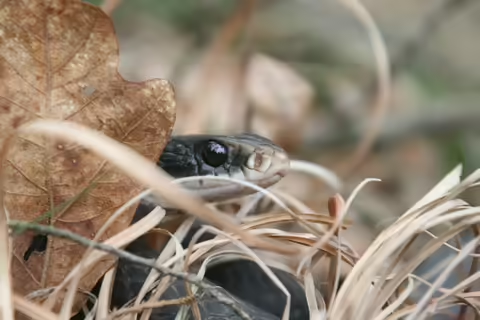URBANA, Ill. – Illinois is world famous for its snakes. Every spring starting in March, Snake Road in the far southern reaches of the state closes to vehicles so migrating reptiles and amphibians can safely cross.
This time of year, snakes are emerging from their winter dens to bask in the sun and seek mates. But if the thought of a road full of snakes sends shivers down your spine, you’re not alone.
As someone who works in conservation, University of Illinois Extension Forester Chris Evans says he’s heard some tall tales about snakes. These whoppers run the gamut from snakes biting their tail form a hoop to roll down a hill to stories of water moccasins harassing fisherman in lakes hundreds of miles north of their range.
“Unfortunately, the phrase ‘the only good snake is a dead snake’ is also one I have heard a lot,” says Evans, who also coordinates the Master Naturalist volunteer corps program. “I’ve found this sentiment and the fear fueling it comes from a lack of knowledge about the snakes homeowners, hikers, campers and other outdoor recreationists share our woods, trails, and waterways with.”
Illinois is home to 40 native species of snake; 11 are state endangered or threatened. Many of the prairie state’s most common species are rarely seen because they spend most of their life underground or in leaf litter. Common garter snakes are frequently sighted in yards, forests, grasslands, empty lots, and everywhere in between.
Like other reptiles, snakes are cold-blooded, meaning they do not produce body heat, instead, their temperature varies with their environment.
“In winter, snakes go through a dormant period called brumation, but they’ll still emerge on warm days,” Evans says. “Sometimes snakes travel quite a distance to find a suitable den.”
Snake Road is famous for this migration phenomenon and closes accordingly from March 15 to May 15 and September 1 to October 30. The narrow country lane in the LaRue-Pine Hills Research Natural Area divides the summer swamp habitat and the winter hibernation sites in the towering chert bluffs.
The road is still open to foot traffic and many snake enthusiasts make it a point to hike Snake Road during the closure for a chance to see any of the 23 species of snakes have been documented there.
If you see a snake, Evans recommends enjoying the moment and possibly taking a photo before leaving it alone.
“Don’t harass or move the snake, and don’t kill it,” he says. “Like other wildlife, reptiles and amphibians are protected by state law.”
The snakes of Illinois are solitary animals that are not aggressive toward people. Bites are rare and almost always occur as a defensive act when the snake was threatened.
Illinois has only four venomous species: timber rattlesnake, eastern massasauga rattlesnake, eastern copperhead, and cottonmouth. They are rare and habitat loss is further reducing their numbers.
Urban and developed environmental can often be difficult places for reptile populations to thrive. Homeowners can attract snakes to their yard for rodent control by skipping manicured landscapes and instead aiming for microhabitats with a patchwork of various plants such as native prairie grasses and shrubs and woodpiles. Learn more at go.illinois.edu/LandscapesforReptiles.
Those who would rather not be surprised by a snake in the backyard can adjust their landscape to make them less appealing. Discourage snakes by keeping plant material short, remove bird feeders during spring and summer, replace loose rock walls with tight-fitting blocks, caulk or seal opening, joints and seams. Learn more at go.illinois.edu/DiscourageSnakes.
For help with a snake question or identification, contact your local Illinois Extension office at go.illinois.edu/ExtensionOffice.
SOURCE: Chris Evans, Forestry Extension and Research Specialist & Interim Master Naturalist Coordinator, Illinois Extension
WRITER: Emily Steele, Communications Coordinator, Illinois Extension
ABOUT EXTENSION: Illinois Extension leads public outreach for the University of Illinois by translating research into action plans that allow Illinois families, businesses, and communities to solve problems, make informed decisions, and adapt to changes and opportunities.
PHOTO ACCESS: The photo in this article is available to download for media use. Credit to Chris Evans.
